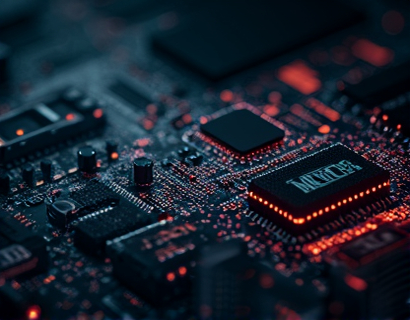Next-Gen Smart Contract AMMs: Revolutionizing DeFi Trading with Advanced Automation
In the rapidly evolving world of decentralized finance, or DeFi, the integration of smart contracts has been pivotal in shaping the future of trading. Among the various innovations, Automated Market Makers (AMMs) powered by advanced smart contracts stand out for their ability to revolutionize liquidity management and trading strategies. This article delves into the cutting-edge technology behind next-generation smart contract AMMs, exploring how they are transforming the DeFi landscape for crypto traders and enthusiasts.
Understanding Smart Contract AMMs
Traditional AMMs rely on algorithms to determine asset prices and manage liquidity pools, eliminating the need for order books and human intervention. Smart contract AMMs take this a step further by leveraging the immutability and transparency of blockchain technology. These AMMs are built on blockchain networks, ensuring that all transactions are secure, verifiable, and tamper-proof.
The core mechanism of a smart contract AMM involves liquidity pools, which are collections of tokens locked in a contract. Users can deposit tokens into these pools and earn liquidity provider (LP) tokens as a reward. The smart contract calculates the price of assets based on the ratio of tokens in the pool, allowing for seamless trading without the need for a centralized exchange.
Advanced Automation in Smart Contract AMMs
One of the most significant advancements in smart contract AMMs is the integration of advanced automation features. These features enable the platform to execute complex trading strategies autonomously, optimizing liquidity and maximizing returns for users. Some of the key automation capabilities include:
- Arbitrage Strategies: Automated systems can detect price discrepancies across different AMMs and execute trades to exploit these differences, ensuring that users benefit from market inefficiencies.
- Risk Management: Smart contracts can implement dynamic risk management protocols, adjusting positions based on market conditions to minimize potential losses.
- Rebalancing: Automated rebalancing of liquidity pools ensures that the token ratios remain within predefined parameters, maintaining the efficiency of the AMM.
- Yield Optimization: Advanced algorithms can identify the most profitable yield-generating strategies, automatically shifting funds between different protocols and assets to maximize returns.
Enhanced Liquidity Management
Liquidity management is a critical aspect of DeFi trading, and smart contract AMMs have introduced innovative solutions to address the challenges traditional AMMs face. One of the primary issues with conventional AMMs is the impermanent loss incurred by liquidity providers when asset prices fluctuate. Next-gen smart contract AMMs mitigate this risk through several mechanisms:
Firstly, dynamic fee structures adjust based on market conditions, incentivizing liquidity provision during periods of high volatility. Secondly, liquidity insurance protocols can be integrated to protect LP tokens from significant price movements, reducing the risk of impermanent loss. Lastly, liquidity aggregators allow users to pool their tokens across multiple AMMs, enhancing liquidity and reducing the impact of individual pool volatility.
User-Centric Features for Crypto Traders
Next-generation smart contract AMMs are designed with the crypto trader in mind, offering a suite of user-centric features that enhance the trading experience. These include:
- Real-Time Market Data: Access to up-to-date market information ensures that traders can make informed decisions quickly.
- Customizable Trading Strategies: Users can set up and manage their own trading algorithms, tailored to their specific strategies and risk tolerance.
- Cross-Chain Compatibility: Support for multiple blockchain networks allows traders to access a broader range of assets and protocols, increasing flexibility and opportunities.
- User-Friendly Interfaces: Intuitive dashboards and interfaces make it easy for both novice and experienced traders to navigate and manage their trades.
Security and Trust in Smart Contract AMMs
Security is paramount in the DeFi space, and smart contract AMMs have implemented robust measures to ensure the integrity of transactions. Key security features include:
- Audited Smart Contracts: Independent audits by reputable firms verify the code for vulnerabilities, providing assurance to users.
- Multi-Signature Wallets: Critical operations require multiple approvals, reducing the risk of unauthorized transactions.
- Transparent Governance: Community-driven governance models allow users to participate in decision-making processes, fostering trust and accountability.
These security measures, combined with the transparency of blockchain, create a trustworthy environment for DeFi trading.
Case Studies and Real-World Applications
Several projects have successfully implemented advanced smart contract AMMs, demonstrating their potential to transform DeFi trading. For instance, Project X introduced a smart contract AMM with dynamic fee adjustments and liquidity insurance, resulting in a 30% increase in LP participation during high-volatility periods. Another project, Platform Y, integrated cross-chain compatibility, allowing users to access a diverse range of assets and protocols, thereby boosting overall liquidity and user engagement.
These case studies highlight the practical benefits of next-gen smart contract AMMs, showcasing improved liquidity, enhanced user experiences, and increased security.
Future Prospects and Challenges
The future of smart contract AMMs in DeFi is promising, with ongoing developments set to address current challenges and unlock new possibilities. Some of the key areas of focus include:
- Scalability Solutions: Improving transaction throughput to handle higher volumes of trades without compromising performance.
- Interoperability: Enhancing cross-platform compatibility to create a more interconnected DeFi ecosystem.
- User Education: Providing resources and tools to help users better understand and utilize advanced AMM features.
Addressing these challenges will be crucial for the widespread adoption of smart contract AMMs and the continued growth of the DeFi space.
Conclusion
Next-gen smart contract AMMs are at the forefront of DeFi innovation, offering advanced automation, enhanced liquidity management, and user-centric features. These technologies are not only optimizing trading strategies but also building a more secure, efficient, and accessible decentralized finance ecosystem. As the DeFi landscape continues to evolve, smart contract AMMs will play a pivotal role in shaping the future of crypto trading.











































